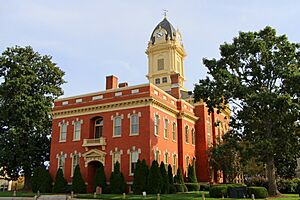Monroe, North Carolina facts for kids
Quick facts for kids
Monroe, North Carolina
|
|||
|---|---|---|---|
|
City
|
|||

Union County Courthouse in Monroe
|
|||
|
|||
| Motto(s):
"Where Heartland Meets High Tech"
|
|||

Location of Monroe, North Carolina
|
|||
| Country | United States | ||
| State | North Carolina | ||
| County | Union | ||
| Named for | James Monroe | ||
| Government | |||
| • Type | Council–manager | ||
| Area | |||
| • Total | 31.54 sq mi (81.68 km2) | ||
| • Land | 30.92 sq mi (80.08 km2) | ||
| • Water | 0.62 sq mi (1.60 km2) | ||
| Elevation | 591 ft (180 m) | ||
| Population
(2020)
|
|||
| • Total | 34,562 | ||
| • Density | 1,117.86/sq mi (431.61/km2) | ||
| Time zone | UTC−5 (Eastern (EST)) | ||
| • Summer (DST) | UTC−4 (EDT) | ||
| ZIP Codes |
28110-28112
|
||
| Area code(s) | 704 980 | ||
| FIPS code | 37-43920 | ||
| GNIS feature ID | 2404284 | ||
Monroe is a city in North Carolina, and it's the main city (called the county seat) of Union County, North Carolina. This means it's where the county government is located. Monroe is part of the bigger Charlotte area, which is growing fast!
In 2010, about 32,797 people lived in Monroe. By 2020, the population grew to 34,551 people. The city is run by a council-manager government. This means elected officials (the council) make decisions, and a city manager handles the daily operations.
Contents
History of Monroe, North Carolina
How Monroe Began
Monroe was officially started in 1843. Back then, leaders chose this spot in the middle of the county to be the main town. They named it after James Monroe, who was the fifth president of the United States.
Early Industries and Growth
Monroe quickly became an important place for trading. Farmers from the surrounding areas would bring their crops, especially tobacco, to sell here.
Since the early 1900s, a famous company called Ludwig has made drums and timpani (large kettledrums) in Monroe. The Ludwig brothers created special ways to make these instruments, like a spring system for timpani that is still used today!
Civil Rights Efforts
After World War II, many places in the state, including Monroe, had segregation. This meant that Black and white people were kept separate in public places. A brave Marine veteran named Robert F. Williams and other Black residents started working for equal rights.
At that time, about 12,000 people lived in Monroe. Williams became the leader of the local NAACP group. He worked to open public places, like the library and swimming pool, to everyone. These places were built with government money and paid for by taxes from all citizens, both Black and white.
Sports and Modern Times
Monroe was home to the Starlite Speedway in the 1960s and 1970s. This dirt track hosted exciting car races, including a NASCAR event in 1966.
Today, as part of the growing Charlotte area, Monroe has welcomed many new residents, including people from Hispanic backgrounds. North Carolina has encouraged new people to move to the state to help with its workforce.
Historic Places in Monroe
Several buildings and areas in Monroe are listed on the National Register of Historic Places. This means they are important historical sites that are protected. Some of these include the Malcolm K. Lee House, Monroe City Hall, and the Union County Courthouse.
Geography and Location
Monroe is located about 5 miles (8 kilometers) northwest of the Charlotte–Monroe Executive Airport (EQY).
The city covers a total area of about 24.9 square miles (64.5 square kilometers). Most of this area is land, with a small part being water.
Population and People
How Many People Live in Monroe?
Monroe's population has grown a lot over the years. Here's a quick look at how the number of people living in the city has changed:
| Historical population | |||
|---|---|---|---|
| Census | Pop. | %± | |
| 1850 | 204 | — | |
| 1860 | 239 | 17.2% | |
| 1870 | 1,144 | 378.7% | |
| 1880 | 1,564 | 36.7% | |
| 1890 | 1,866 | 19.3% | |
| 1900 | 2,427 | 30.1% | |
| 1910 | 4,082 | 68.2% | |
| 1920 | 4,084 | 0.0% | |
| 1930 | 6,100 | 49.4% | |
| 1940 | 6,475 | 6.1% | |
| 1950 | 10,140 | 56.6% | |
| 1960 | 10,882 | 7.3% | |
| 1970 | 11,282 | 3.7% | |
| 1980 | 12,639 | 12.0% | |
| 1990 | 16,127 | 27.6% | |
| 2000 | 26,228 | 62.6% | |
| 2010 | 32,797 | 25.0% | |
| 2020 | 34,551 | 5.3% | |
| 2021 (est.) | 34,888 | 6.4% | |
Monroe's Diverse Community (2020 Census)
In 2020, there were 34,562 people living in Monroe. The city is home to a diverse mix of people.
| Group | Number | Percentage |
|---|---|---|
| White (not Hispanic) | 14,118 | 40.85% |
| Black or African American (not Hispanic) | 7,787 | 22.53% |
| Native American | 97 | 0.28% |
| Asian | 390 | 1.13% |
| Pacific Islander | 15 | 0.04% |
| Other/Mixed | 1,216 | 3.52% |
| Hispanic or Latino | 10,939 | 31.65% |
Monroe's Population Details (2010 Census)
In 2010, Monroe had 32,797 people living in 9,029 households. The average household had about 2.83 people.
The population was spread out by age:
- About 26.9% were under 18 years old.
- About 32.6% were between 25 and 44 years old.
- About 10.8% were 65 years or older.
The median age in the city was 31 years. This means half the people were younger than 31 and half were older.
Sports in Monroe
Monroe has been home to a couple of minor league baseball teams. The Monroe Indians played in 1969, and the Monroe Pirates played in 1971.
Media and News
If you want to know what's happening in Monroe, you can read the local newspaper, The Enquirer-Journal. It comes out three times a week. You can also listen to local radio stations like WIXE 1190 AM and WDZD 99.1 FM.
Transportation in Monroe
Roads and Highways
Two main roads, U.S. Route 74 and U.S. Route 601, pass through Monroe. There's also the Monroe Expressway, which helps drivers get around the city more easily.
Airports Near Monroe
The Charlotte–Monroe Executive Airport (EQY) is just 5 miles (8 kilometers) northwest of Monroe. For bigger flights, the Charlotte Douglas International Airport is about 37 miles (60 kilometers) northwest of the city.
Train History
In the past, passenger trains used to travel through Monroe on their way to cities like Raleigh, Athens, and Atlanta. One famous train was the Silver Comet. Train service to Monroe ended in 1969.
Notable People from Monroe
Many interesting people have come from Monroe, North Carolina! Here are a few:
- Adrian Autry: A former professional basketball player who is now a coach.
- Thomas Walter Bickett: He was the 54th Governor of North Carolina.
- Gil Coan: A player in Major League Baseball.
- Jamison Crowder: An NFL wide receiver for the New York Jets.
- Christine Darden: An amazing aeronautical engineer who worked at NASA. She was the first African-American woman at NASA to reach a very high leadership position.
- JoJo Hailey and K-ci Hailey: Famous R&B and soul singers.
- Jesse Helms: A U.S. Senator.
- Michael Macchiavello: A national champion wrestler.
- John J. Parker: A U.S. judge who served on the Nuremberg Trials.
- Robert F. Williams: A very important civil rights activist.
See also
 In Spanish: Monroe (Carolina del Norte) para niños
In Spanish: Monroe (Carolina del Norte) para niños



